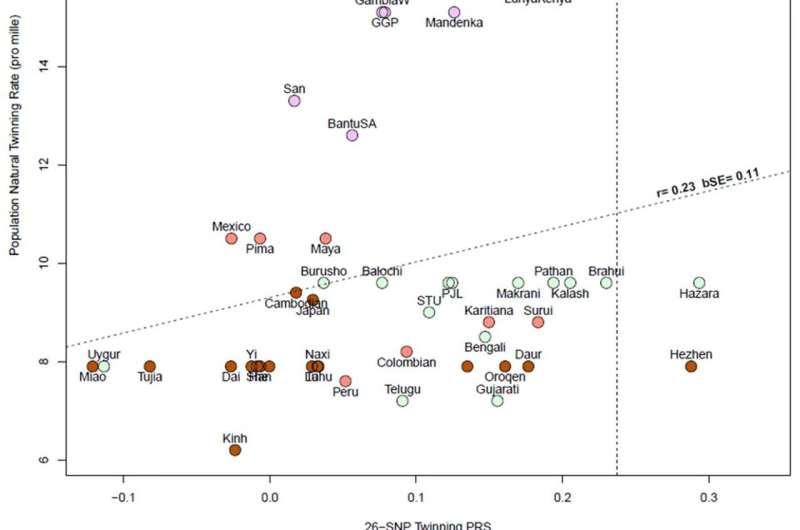This article has been reviewed according to Science X's editorial process and policies. Editors have highlighted the following attributes while ensuring the content's credibility:
fact-checked
proofread
Research reveals the genetic code behind non-identical twins

A QIMR Berghofer-led international team of scientists has unlocked the genetic secrets behind why some mothers are more likely than others to conceive twins.
The study, published in Human Reproduction, has identified seven genes that regulate the female propensity for giving birth to spontaneous dizygotic (DZ) twins, otherwise known as non-identical twins.
Non-identical twins occur when a woman releases two eggs during ovulation and these are fertilized by two different sperm to form two separate zygotes, resulting in the birth of DZ twins. These are just like ordinary siblings, except they are gestated and born at the same time.
The findings establish that a simple saliva-based genetic test may reveal a woman's likelihood of producing twins. The same test may also have implications for female fertility and potentially predict which women are likely to have trouble conceiving.
Researchers are now calling on all mothers of non-identical twins to take part in the Genetics of Dizygotic Twinning study to strengthen their ability to predict which women are twin-prone and which are likely to have infertility problems.
Lead author, QIMR Berghofer researcher, Professor Nick Martin said the group had studied thousands of DNA samples provided by mothers of non-identical twins in Australia and internationally over many years to identify what genes they have in common.
"It has long been known that fraternal twins have a genetic basis, with non-identical twins often running in families. However, identifying the genetic factors which cause fraternal twins has been like searching for a needle in a haystack," said Professor Martin.
"Powerful technology called gene chips has helped advance this research. We combined data from five independent studies in Australia, The Netherlands, United States, United Kingdom (U.K.) and Iceland on 8,265 mothers of spontaneous DZ twins and 264,567 controls, as well as U.K., Finnish and Swedish data on independent DZ twin offspring," he said.
All participants provided DNA samples which were then typed using the gene chips to identify close to 1 million gene variants, which are genetic markers spread all the way across the 23 human chromosomes.
The frequencies of the gene variants between mothers of DZ twins, DZ twins themselves, and the mothers of single offspring were then compared in what is known as a genome-wide association study (GWAS).
Professor Martin said five of the identified genes have known roles in female reproduction, affecting the follicle stimulating hormone (FSH) pathway, well known to women undergoing fertility treatments.
"Two of the identified genes have not previously been associated with the possibility of twinning.
"This is just the start. We have isolated seven genes but we know there are more to find. As the number of mothers in our study increases, we will be able to identify more genes and to predict which women may be super-fertile and prone to having twins," said Professor Martin.
The study's results also predicted that ovarian insufficiency could cause female infertility.
"The findings are also important when we consider women who struggle with fertility, as they are at the opposite end of the genetic spectrum from those women who have twins," said Professor Martin.
"This suggests that it might be possible to predict from a DNA test which women are likely to have trouble conceiving, meaning we can provide valuable knowledge to people which they might use to start planning their families early."
Saskia Bollmann, mother of 2-year old twins, Max and Pip, said they were the first to have twins in her extended family.
"It was a huge surprise. I'm curious as to why we had twins and if any of my family may also have twins going forward," she said
"I understand the propensity to have twins is also related to fertility, and we have seen many friends struggle with fertility, so from that perspective this research is very important.
"I signed up for the study. It was easy and uncomplicated. For gene studies to be meaningful they need many participants and I think it's really valuable. I would definitely encourage other mothers of twins to participate in the study," explained Saskia.
To continue investigating this genetic mystery, Professor Martin is encouraging all mothers of non-identical twins to take part in the Genetics of Dizygotic Twinning study. It involves answering a two-minute questionnaire and providing a saliva sample. Visit https://www.qimrberghofer.edu.au/nonidenticaltwinning/ to register.
More information: Hamdi Mbarek et al, Genome-wide association study meta-analysis of dizygotic twinning illuminates genetic regulation of female fecundity, Human Reproduction (2023). DOI: 10.1093/humrep/dead247
















